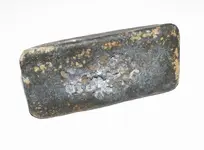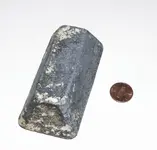The civil war armies did not carry ingots of metal around with them. Nearly all of a civil war army's bullets were made by an Arsenal or a commercial manufacturer (such as C.D. Leet & Co.), and issued to the soldiers by the Ordnance Department. A few soldiers bought their own pistols from commercial gun manufacturers and sellers (such as "sutlers"), who supplied a bulletmold with the pistol. In such cases, those soldiers purchased small-ish flat bars of lead for use with the personally-owned bulletmold. Photos of some small-ish lead bars dug from civil war military campsites are pictured in various relic-books, such as "Excavated Artifacts From Battlefields and Campsites of the Civil War" by Stanley S. Phillips.
The reason long small-ish bars (approximately 1/2-to-3/4-inch wide) were used instead of short very-thick ingots is that such ingots require a much hotter fire to melt them in comparison to the little bars.
I'm quite certain that the very-thick ingot you found is not lead (meaning, pure lead). It may be a solder-like alloy. Solder is (most commonly) an alloy of lead with a very significant amount (such as a 60/40 ratio) of Zinc or Tin. The spotty white oxidation on your indicates a significant amount of Zinc content.
I don't know how your ingot came to be at the location where you found it, but I am reasonably certain that it isn't there because of activity by civil war soldiers.





